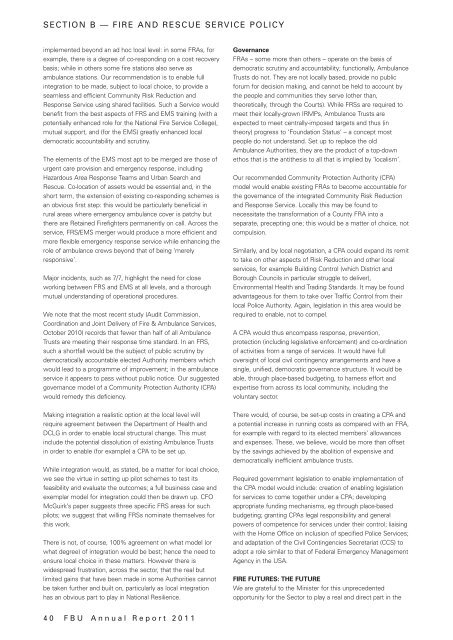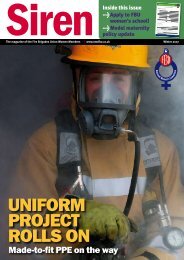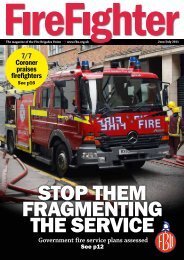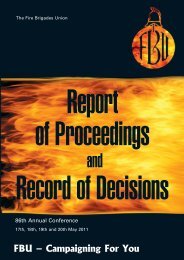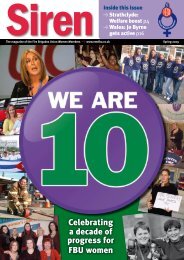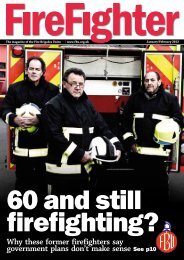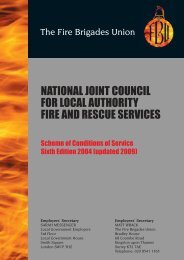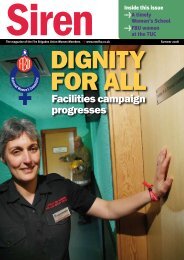Report - Fire Brigades Union
Report - Fire Brigades Union
Report - Fire Brigades Union
Create successful ePaper yourself
Turn your PDF publications into a flip-book with our unique Google optimized e-Paper software.
SECTION B — FIRE AND RESCUE SERVICE POLICY<br />
implemented beyond an ad hoc local level: in some FRAs, for<br />
example, there is a degree of co-responding on a cost recovery<br />
basis; while in others some fire stations also serve as<br />
ambulance stations. Our recommendation is to enable full<br />
integration to be made, subject to local choice, to provide a<br />
seamless and efficient Community Risk Reduction and<br />
Response Service using shared facilities. Such a Service would<br />
benefit from the best aspects of FRS and EMS training (with a<br />
potentially enhanced role for the National <strong>Fire</strong> Service College),<br />
mutual support, and (for the EMS) greatly enhanced local<br />
democratic accountability and scrutiny.<br />
The elements of the EMS most apt to be merged are those of<br />
urgent care provision and emergency response, including<br />
Hazardous Area Response Teams and Urban Search and<br />
Rescue. Co-location of assets would be essential and, in the<br />
short term, the extension of existing co-responding schemes is<br />
an obvious first step: this would be particularly beneficial in<br />
rural areas where emergency ambulance cover is patchy but<br />
there are Retained <strong>Fire</strong>fighters permanently on call. Across the<br />
service, FRS/EMS merger would produce a more efficient and<br />
more flexible emergency response service while enhancing the<br />
role of ambulance crews beyond that of being ‘merely<br />
responsive’.<br />
Major incidents, such as 7/7, highlight the need for close<br />
working between FRS and EMS at all levels, and a thorough<br />
mutual understanding of operational procedures.<br />
We note that the most recent study (Audit Commission,<br />
Coordination and Joint Delivery of <strong>Fire</strong> & Ambulance Services,<br />
October 2010) records that fewer than half of all Ambulance<br />
Trusts are meeting their response time standard. In an FRS,<br />
such a shortfall would be the subject of public scrutiny by<br />
democratically accountable elected Authority members which<br />
would lead to a programme of improvement; in the ambulance<br />
service it appears to pass without public notice. Our suggested<br />
governance model of a Community Protection Authority (CPA)<br />
would remedy this deficiency.<br />
Making integration a realistic option at the local level will<br />
require agreement between the Department of Health and<br />
DCLG in order to enable local structural change. This must<br />
include the potential dissolution of existing Ambulance Trusts<br />
in order to enable (for example) a CPA to be set up.<br />
While integration would, as stated, be a matter for local choice,<br />
we see the virtue in setting up pilot schemes to test its<br />
feasibility and evaluate the outcomes; a full business case and<br />
exemplar model for integration could then be drawn up. CFO<br />
McGuirk’s paper suggests three specific FRS areas for such<br />
pilots; we suggest that willing FRSs nominate themselves for<br />
this work.<br />
There is not, of course, 100% agreement on what model (or<br />
what degree) of integration would be best; hence the need to<br />
ensure local choice in these matters. However there is<br />
widespread frustration, across the sector, that the real but<br />
limited gains that have been made in some Authorities cannot<br />
be taken further and built on, particularly as local integration<br />
has an obvious part to play in National Resilience.<br />
Governance<br />
FRAs – some more than others – operate on the basis of<br />
democratic scrutiny and accountability; functionally, Ambulance<br />
Trusts do not. They are not locally based, provide no public<br />
forum for decision making, and cannot be held to account by<br />
the people and communities they serve (other than,<br />
theoretically, through the Courts). While FRSs are required to<br />
meet their locally-grown IRMPs, Ambulance Trusts are<br />
expected to meet centrally-imposed targets and thus (in<br />
theory) progress to ‘Foundation Status’ – a concept most<br />
people do not understand. Set up to replace the old<br />
Ambulance Authorities, they are the product of a top-down<br />
ethos that is the antithesis to all that is implied by ‘localism’.<br />
Our recommended Community Protection Authority (CPA)<br />
model would enable existing FRAs to become accountable for<br />
the governance of the integrated Community Risk Reduction<br />
and Response Service. Locally this may be found to<br />
necessitate the transformation of a County FRA into a<br />
separate, precepting one; this would be a matter of choice, not<br />
compulsion.<br />
Similarly, and by local negotiation, a CPA could expand its remit<br />
to take on other aspects of Risk Reduction and other local<br />
services, for example Building Control (which District and<br />
Borough Councils in particular struggle to deliver),<br />
Environmental Health and Trading Standards. It may be found<br />
advantageous for them to take over Traffic Control from their<br />
local Police Authority. Again, legislation in this area would be<br />
required to enable, not to compel.<br />
A CPA would thus encompass response, prevention,<br />
protection (including legislative enforcement) and co-ordination<br />
of activities from a range of services. It would have full<br />
oversight of local civil contingency arrangements and have a<br />
single, unified, democratic governance structure. It would be<br />
able, through place-based budgeting, to harness effort and<br />
expertise from across its local community, including the<br />
voluntary sector.<br />
There would, of course, be set-up costs in creating a CPA and<br />
a potential increase in running costs as compared with an FRA,<br />
for example with regard to its elected members’ allowances<br />
and expenses. These, we believe, would be more than offset<br />
by the savings achieved by the abolition of expensive and<br />
democratically inefficient ambulance trusts.<br />
Required government legislation to enable implementation of<br />
the CPA model would include: creation of enabling legislation<br />
for services to come together under a CPA; developing<br />
appropriate funding mechanisms, eg through place-based<br />
budgeting; granting CPAs legal responsibility and general<br />
powers of competence for services under their control; liaising<br />
with the Home Office on inclusion of specified Police Services;<br />
and adaptation of the Civil Contingencies Secretariat (CCS) to<br />
adopt a role similar to that of Federal Emergency Management<br />
Agency in the USA.<br />
FIRE FUTURES: THE FUTURE<br />
We are grateful to the Minister for this unprecedented<br />
opportunity for the Sector to play a real and direct part in the<br />
40 FBU Annual <strong>Report</strong> 2011


